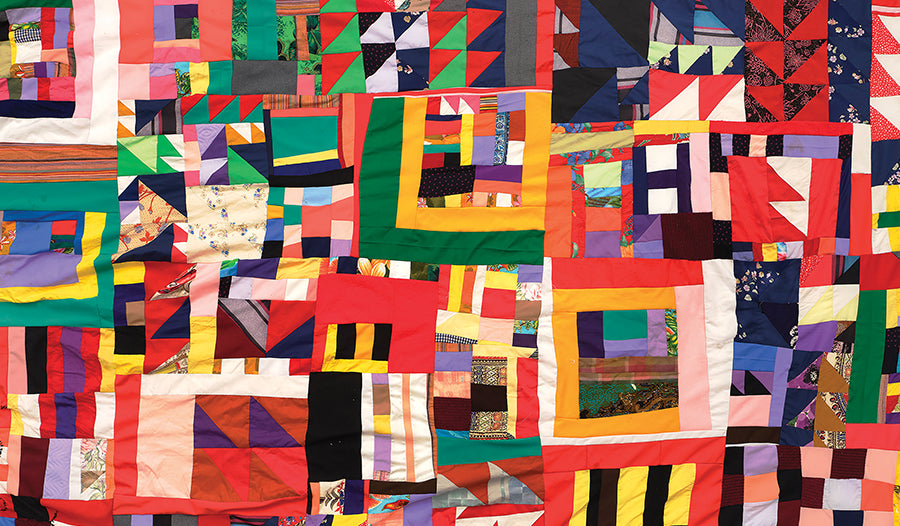
It is difficult to imagine the place of textiles in contemporary art today without Rosie Lee Tompkins’ bold improvisational quilts. She thrived beyond the conventions of textile-making and transformed it into a sensorial, emotional and spiritual experience. Tompkins’ textiles are radical in their materials and meaning; they supersede categorisation and sit between therapeutic art and storytelling. Her quilts are expressions of her limitless imagination and the result of countless experiments with manufacturing techniques, colours and texture.

Image: Untitled, 2004 (circa) Quilted by Irene Bankhead 2007 printed cotton, polyester, woven wool, velour, cotton flannel, wool, cotton embroidery, and other fabrics with cotton muslin backing 100 x 134cm.
Born Effie Mae Martin Howard in rural Gould, Arkansas in 1936, the artist worked behind the pseudonym Rosie Lee Tompkins. She grew up the eldest of 15 half-siblings, picking cotton and making quilts with her mother. Their small hometown was an epicentre for quilt creativity where Tompkins’ female friends and relatives shared their knowledge and taught one another quilting traditions. But it was from 1980 onwards, when Tompkins was working as a practical nurse, that she began to quilt more religiously. A private and pious woman, she believed God directed her hand as she quilted; ‘I think it’s because I love them so much that God let me see all these different colours’. Her visual wit and improvisational method were, to her, a testament to the divine interventions she saw shaping her abstract compositions. This is perhaps most evident in her pieces that directly reference the Bible; in a 2002 quilt, one can read the names of the Four Evangelists in a cotton landscape of embroidered crosses. Later in her life, Tompkins moved to Richmond, California, a town just north of Berkeley that became a destination for thousands of African Americans migrating from the South. She would remain there until her death in 2006.

Image: Untitled 2002 (circa), cotton, printed cotton, polyester, canvas, knit velour, polyester fleece, wool, polyester knit, polyester double knit, cotton embroidery, and buttons, 264 x 368 cm.
Tompkins worked in a nursing home for twenty years; a period during which she would make numerous quilts to sell at flea markets. There, she would find an array of cheap materials for her work, from crocheted doilies to chunky costume jewellery. Such markets would attract quilt collectors too and in 1985, her work caught the eye of Eli Leon, an Oakland-based art collector devoted to the work of African American quilters and artisans. Thereafter, Leon would frequently buy her work as part of his collection of quilts that would eventually number in the thousands. By 1987, Leon featured her work in the exhibition Who’d A Thought It: Improvisation in African-American Quiltmaking alongside Francis Sheppard and Arbie Williams’ quilts. Ten years later, Tompkins’ quilts were displayed in a solo exhibition at the Berkeley Art Museum and Pacific Film Archive and continue to be celebrated in various international museum collections and galleries today. The majority of Tompkins’ work now resides in the Berkeley Art Museum thanks to a large bequest of over 3,100 quilts from Eli Leon’s collection of 400 African American artists.

Tompkins’ early business card promised ‘Crazy Quilts and Pillows All Sizes’ and she certainly delivered. She began each quilt by cutting her shapes freehand, never measuring or using a template, and would intuitively create her mosaic-like patterns from there. Her abstract compositions, or what Leon called ‘flexible patterning’, are evidence of her constant improvisations. The textural surfaces create the illusion of motion and a mesmerising flow of fragmented textiles. The syncopated rhythm of her improvisations erupts in rich colours to create a fusion of materials. One of Tompkins’ largest works was 365cm long and evoked a wonderful map of America’s melting pot of cultures. A quilt within a quilt, it mixed tea towels illustrated with folkloric scenes and bright renditions of the Stars and Stripes flag alongside Mexican textiles, embroidered racing cars and a commercial print of Jesus Christ...
Extract from the article Spiritual Stitches: Rosie Lee Tompkin's Improvisational Quilts from Issue 98 Together. Find out how to read the rest of the article here.
--

From Rosie Lee Tompkins bold improvisational quilts and antique Dutch darning samplers, to Indian chintz and Mexican tenango embroidery, wake up to the beauty of textiles from around the world every day of the year with the Selvedge 2022 Calendar.
Featuring 12 beautiful textiles featured in Selvedge Magazine, this is the perfect gift for the textile lover in your life (even if that is you!).

